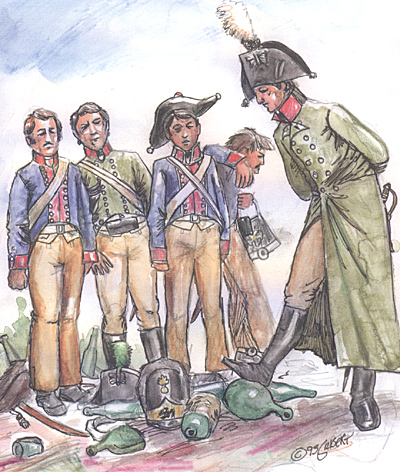For readers who remain skeptical we might add that
after the disaster of Jena-Auerstadt, and the subsequent
bagging of many of the defeated Prussians by the pursuing
French army, what was left of the Prussian army in East
Prussia fought very well alongside the Russians. The
performance and success of Lestoc's small command at
Eylau against Davout's IIIrd Corps is proof of that.
It looks like the Jager Officer on the right caught the boys doing some heavy drinking. From left to right are A Musketeer, A Foot Jager, a Musketeer supporting another Musketeer who in spite of his instability problem has managed to grab a Fusilier shako.
Let us not forget that Bressonet
[2]
said: In 1806, beside the cavalry and artillery, the bulk of
the Prussian army was provided by 60 line infantry
regiments including that of the Guard (112 line battalions
and 4 battalions of Guards
[3]
), and 28 Grenadier battalions. In addition to the line
infantry, we find 24 Fusilier battalions and 1 Foot Jager
regiment of light infantry.
Each infantry regiment consisted of 2 Musketeer field
battalions and 2 companies of Grenadiers, plus a depot
battalion later known as the 3rd Musketeer battalion. On
war footing, each Musketeer battalion consisted of 5
companies [4] with a
total of 600 privates, 50 Schutzens, and 40 reserve. In
addition, the battalion had 22 officers, 60 NCOs, 1 artillery
NCO, 17 gunners manning 1 battalion gun and 10 sappers.
Each Fusilier battalion consisted of 19 officers, 48
NCOs, 13 musicians [5]
80 corporals, 440 privates, 40 reserves, 40 Schutzens
[6]
, 8 sappers, 4 artillery auxiliaries to help the artillerists man
the 3-pdr battalion gun and some 46 train soldiers, a total of
744 men among which were 688 combatants organized in 4
companies.
The Fusilier battalions were given numbers and, like
the line regiments and Grenadier battalions, were named
after their battalion commanders. The Fusiliers were
organized into 8 brigades of 3 battalions each. The brigades
were named for their garrison locations.
In 1806, the Jager regiment
[7]
numbered about 2000 men organized into 10 companies
which included 51 officers, 120 NCOs, 36 buglers, 1800
privates, 126 train soldiers, 4 artillery laborers and 12
company surgeons.
In 1806, in spite of some changes, the Prussian army
uniforms were almost identical to those of Frederick's army,
and like the Saxon army, they presented an outmoded look
when compared to other armies. Some changes were
introduced by Frederick William II as soon as he succeeded
Frederick in 1786.
His reign was short and his son Frederick William III
replaced him in 1797. Frederick William III continued the
modernization of the infantry uniform with mixed results.
We should mention that the introduction of the shako in
1801 and of the shorter coat for the Fusiliers were the
notable steps in the modernization of the Prussian infantry uniform.
1796 Prussian Uniforms of the 1806 Campaign Part I: The Line Infantry
 In spite of what has been said by many historians,
the 1806 Prussian soldier fought well as has been shown in
the extensive coverage we have already had in the new
EE&L. [1]
In spite of what has been said by many historians,
the 1806 Prussian soldier fought well as has been shown in
the extensive coverage we have already had in the new
EE&L. [1]
"At Saalfeld, Auerstadt, Iena, the French were
victorious. But in spite of the fact that they were under the
command of men such as Lannes, Davout and Napoleon,
and despite the French numerical superiority at Iena,
victory was only achieved at the price of a fierce
struggle."
Back to Empire, Eagles, & Lions Table of Contents Vol. 2 No. 4
Back to EEL List of Issues
Back to MagWeb Master Magazine List
© Copyright 1994 by Emperor's Headquarters
This article appears in MagWeb (Magazine Web) on the Internet World Wide Web.
Other articles from military history and related magazines are available at http://www.magweb.com
